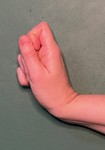Muṣṭisvastika
Nṛttahastas - Dance hands (single and combined)
Descriptions and Meanings
9:198
When two Khaṭakāmukha hands are bent at the wrists and moved round they shall be called Muṣṭisvastika.
9:194
Muṣṭikasvastika—the two Kaṭakāmukha hands bent at the wrists and moved round.
No verse annotation
Muṣṭi-svastika (crossed fists): Musti hands are crossed on the stomach Patron deity Kimpurusa.
No verse annotation:
playing ball, boxing, great bashfulness, tying the girdle.
8:538-539
When two Musṭi hastas are crossed on the stomack, it is Musṭiswastika hasta. Its presiding deity is Kimpurusha.
8:538-539:
This hasta is used to denote playing the ball (made of flowers etc.) boxing, great bashfulness and tying the girdle.
4:1264-1265
Muṣṭisvastika: The hands which are in the Khatakamukha Hasta at the chest are bent at the wrists and then moved round.
7:95
Mustikasvastika: When both svastika katakasya hastas (hands) are once or many times co curved, it is mustika svastika.
2:273
Kaṭakāmukhas are then crossed in muṣṭisvastika hastas. Those born mutually from muṣṭi come under this according to Bharata.
2:274
Any one of muṣṭi, sikhara, kapittha or kaṭakāmukha can be used. Traditionally, as the other three hastas have taken birth from muṣṭi, Bharata named these hastas muṣṭivastika.

Kaṭakāmukha - 2:113-114

Kapittha - 2:137

Ṡikhara - 2:139

Mushṭi - 2:145
Not included elsewhere
2:275
One hasta is contracted downward (kuncita) with muṣṭi and the other arched upward with kaṭakāmukha. Those are muṣṭisvastika hastasas said by Kirtidharacarya. 'khahgavartinika' is another name given to these hastas.

Kaṭakāmukha - 2:113-114

Mushṭi - 2:145 No image available
Kuñcita - 2:222
Not included elsewhere
:887
If the two Aralas are contracted back from the front to form two Khatakamukhas on the shoulders, it is called Mustikasvastika
7:124
When khaṭakā (mukha) hastas are crossed repeatedly < avrttau > it is mustika- svastika.
3:517-518
In muṣṭisvastika, one hand in arāla is moved in vartana while the other hand in alapallava [is moved] several times, alternately assuming the svastika gesture, and finally both the hands perform khatakamukha hand-gestures. Some experts say that in muṣṭisvastika, svastika gestures can also be formed either with Sikhara or kapittha hands.
![That is known as arala where the thumb is bent like a bow at first, the palm is curved in the middle and the rest of [the fingers] are half bent touching [each other].](https://lakshmiammanswebsite-live-00aaba1203334-2b2b45f.divio-media.com/filer_public_thumbnails/filer_public/39/61/396110c6-3b76-49b9-b450-f298cef12d5b/sarpasirsa.jpg__150x150_q90_subsampling-2.jpg)
Arāla - 3:355-357

Ṡikhara - 3:367-368

Kapittha - 3:369

Kaṭakāmukha - 3:372
Mentioned by:
![Lata hands become valita when the elbows are crossed in svastika. Others say that when the tips of the hands are joined with one another facing up in khatkamukha [they form] valita. Others [suggest] that mustikasvastika hands, held up, make valita.](https://lakshmiammanswebsite-live-00aaba1203334-2b2b45f.divio-media.com/filer_public_thumbnails/filer_public/23/44/23445cbe-a701-4583-af5a-4c7cc1f05272/valita.jpg__50x50_q90_subsampling-2.jpg) Valita
Valita

